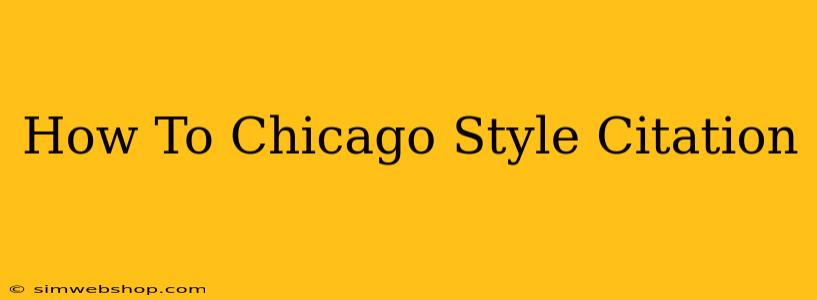The Chicago style citation, also known as the Chicago Manual of Style, is a widely used author-date citation format, particularly in the humanities. Mastering it can significantly enhance the credibility and professionalism of your academic work. This guide will walk you through the essential elements of Chicago style citation, covering both in-text citations and bibliography entries.
Understanding the Basics of Chicago Style
The core principle of Chicago style is to provide the reader with enough information to easily locate the source. This involves providing concise citations within your text and then compiling a complete bibliography at the end of your work. Unlike other citation styles, Chicago offers two primary systems:
-
Notes and Bibliography: This system uses footnotes or endnotes for in-text citations and a comprehensive bibliography at the end. It is particularly useful for works with numerous or complex citations.
-
Author-Date: This system, increasingly preferred, uses parenthetical author-date citations in the text and a bibliography at the end. This method is generally considered more concise.
This guide focuses on the Author-Date system due to its growing popularity and ease of use.
In-Text Citations: The Author-Date System
In-text citations in Chicago style are typically brief and placed within parentheses at the end of the sentence containing the information. They generally follow this format: (Author's last name, year, page number).
Examples:
-
Single Author: (Smith 2023, 15). This indicates a citation from a work by Smith, published in 2023, on page 15.
-
Two Authors: (Smith and Jones 2023, 15).
-
Three or More Authors: (Smith et al. 2023, 15). "et al." is an abbreviation for "and others."
-
Multiple Works by the Same Author in the Same Year: (Smith 2023a, 15) and (Smith 2023b, 20). Use lowercase letters (a, b, c, etc.) to distinguish between multiple works by the same author published in the same year.
-
No Page Numbers (e.g., websites): If a source doesn't have page numbers, omit the page number. For example: (Smith 2023).
-
Direct Quotes: When directly quoting, always include the page number (or equivalent locator, such as paragraph number). For example: "This is a direct quote" (Smith 2023, 15).
Creating a Bibliography: Essential Elements
The bibliography, located at the end of your work, provides full bibliographic information for each source cited. The formatting varies slightly depending on the source type. Here are some common examples:
Books:
-
Author's Last Name, Author's First Name. Title of Book. Place of Publication: Publisher, Year.
Example: Smith, John. The History of Chicago. Chicago: University of Chicago Press, 2020.
Journal Articles:
-
Author's Last Name, Author's First Name. "Title of Article." Title of Journal Volume Number, Issue Number (Year): Pages.
Example: Jones, Mary. "The Impact of Urbanization." Journal of Urban Studies 5, 2 (2021): 123-145.
Websites:
-
Author's Last Name, Author's First Name (if available). "Title of Page." Name of Website. Date of Access.
Example: "Chicago History." Encyclopedia Britannica. Accessed 15 October 2023.
Other Source Types:
The Chicago Manual of Style provides detailed guidelines for many other source types, including reports, dissertations, conference papers, and more. Consult the official style guide for specific formatting instructions.
Tips for Success with Chicago Style Citations
- Consistency is Key: Maintain consistent formatting throughout your paper and bibliography.
- Accuracy Matters: Double-check all information to ensure accuracy. Errors can undermine your credibility.
- Use a Citation Management Tool: Tools like Zotero or Mendeley can significantly simplify the citation process.
- Consult the Official Guide: The Chicago Manual of Style itself is the ultimate authority.
By following these guidelines and consistently applying them, you can effectively use Chicago style citations to present your research in a clear, professional, and academically sound manner. Remember to always consult the most up-to-date edition of the Chicago Manual of Style for the most comprehensive and accurate information.

